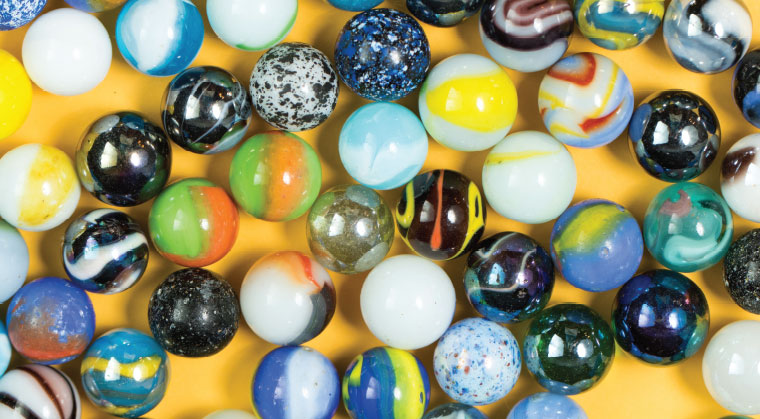Marvelous Marbles


Marbles have been a popular toy for a long time. They’ve been found in Egyptian pyramids, in North American Indian burial grounds, and in the ashes of Pompeii. Marbles are even mentioned in Roman literature. But none of those marbles were made of marble! They were usually round stones, nuts, baked clay, or pottery balls.
In medieval times, marbles were played in Europe. In 1503 the German city of Nuremberg created a law saying that marble games were only allowed to be played in a field outside the town!
Eventually, marbles made their way to Britain and then to the US. By then, most marbles were made of either stone or clay. In the early 1800s, marbles were so popular that The Boys’ Own Book, published in New York in 1829, listed the rating of different marbles. Dutch glazed clay marbles were the cheapest, next were yellow stone marbles with spots of black or brown, and most expensive were pink stone with red veins.
Glass marbles became popular around 1860 after a German glassblower invented “marble scissors,” a tool that could cut the molten glass into a ball shape. From then until the early 1900s, Germany was the master of marble production, producing thousands of beautiful handmade glass marbles. But marble marbles? Nope, sorry — never was such a thing!
Modern Marbles
In 1903 Martin F. Christensen of Akron, Ohio invented a machine that made perfectly round glass marbles. These were much better than the German handmade marbles, as they didn’t have a “pontil” (the little spot where the glassblower’s tool had been attached) and so they were much smoother and rolled better. Also, now that marbles could be made by machine, they could be mass-produced. Soon, Christensen’s factory was turning out about a million marbles every day. Marbles could be sold much more cheaply now, and the Ohio factory took over the lead in world marble production.
Now that they were so cheap, marbles became wildly popular — but the chaos of the Second World War put a damper on things. Then, around the 1970s, video games became popular and marbles lost their appeal.
Today, marbles have come back into fashion — sales of marbles in toy stores almost doubled in the last few years! Over 90% of marbles today are made in Mexico. Marbles are also used for many games, such as Chinese checkers, solitaire, Abalone, and Ker-Plunk. And some people love marbles so much they even collect them!
A Marble by Any Other Name
There are three main categories of marbles — non-glass, machine-made, and handmade. Non-glass marbles include “alleys” (made of alabaster), “aggies” (made of agate), “commies” (made of clay), “steelies” (made of steel), wood, stone, and even papier-mâché! Marbles also have names according to their design or color. There’s the “tiger,” with orange-yellow stripes, and marbles with colorful streaks such called the “corkscrew,” “spiral,” or “snake,” depending on their design. Yellow-and-black striped marbles are called “bumblebee” marbles, and marbles with colored eye-shaped cores are called “cat’s-eyes.” You could have a colorful, striped “beachball,” or a “Devil’s eye” — red with yellow eye. An “onionskin” is an antique, handmade German marble with a specific kind of swirl. There are also “toothpastes,” “oxbloods,” “babies,” “swirlies,” “green ghosts” and “blue moons.” Last but not least are sulphides — these antique, handmade marbles are large clear glass spheres with a small figure inside — usually a cute animal! You’ll never think of marbles as plain glass balls again!
(Excerpted from Mishpacha Jr., Issue 748)
Oops! We could not locate your form.







